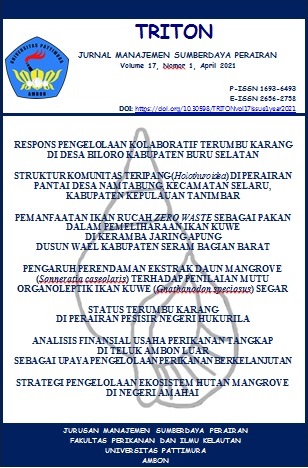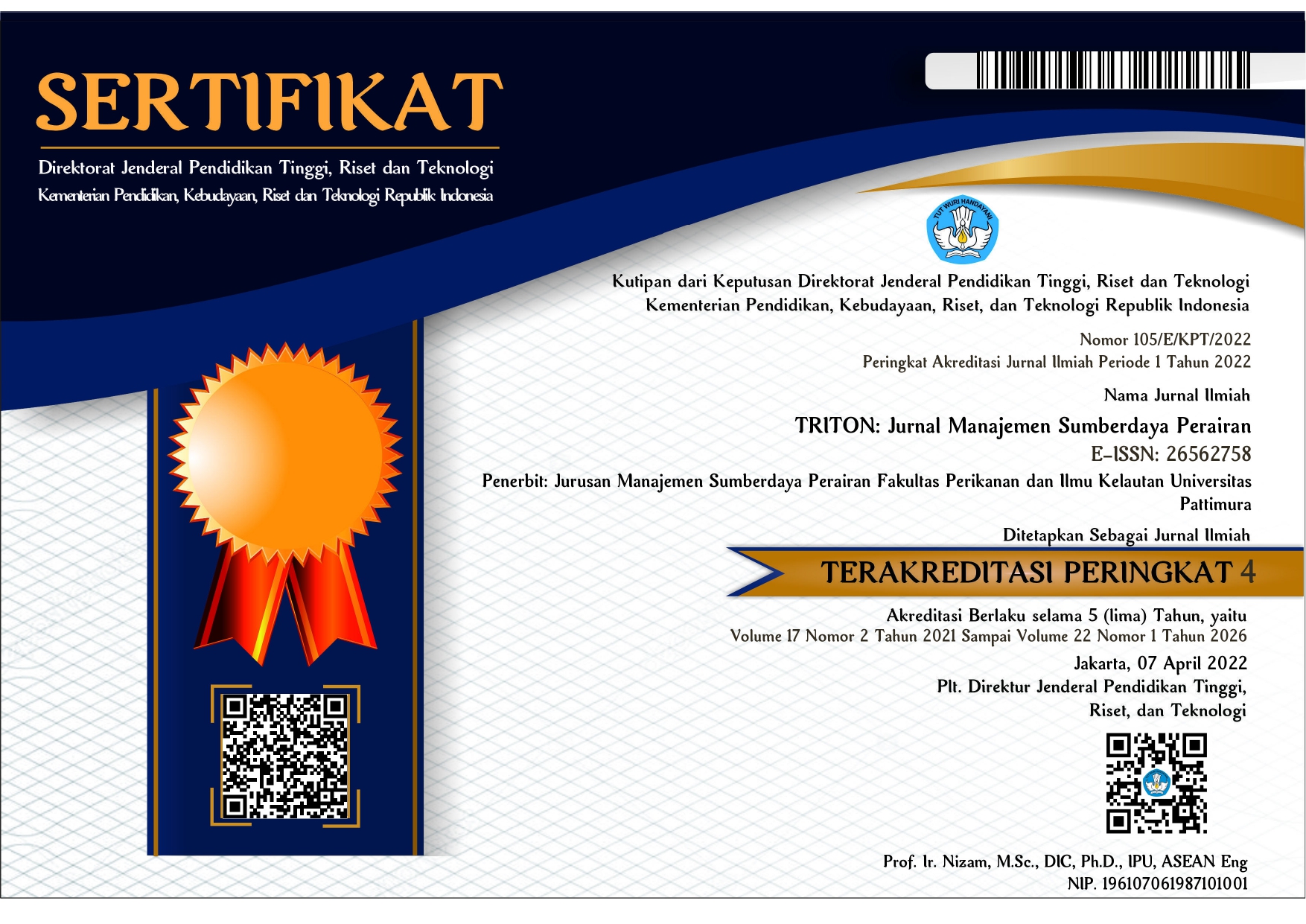RESPONS PENGELOLAAN KOLABORATIF TERUMBU KARANG DI DESA BILORO KABUPATEN BURU SELATAN
Abstract
The use of the coral ecosystem causes a systemic impact on that ecosystem. There are various types of coral reef ecosystem utilization, and the management of this ecosystem, therefore, needs a collaborative approach. The objective of this study was to identify the condition of coral reef, to identify types of utilization and its impact on the coral reef ecosystem and produce a collaborative management response towards the coral reef ecosystem. The research was conducted n July 2020 at the coral reef area of Biloro Village, Sub-district of Kapala Madang, Southern Buru. Field observation uses the Line Intercept Transect method for coral reef condition assessment, while the PRA approach to identify trigger factors, stress against the environment, the impact, and strategic adaptive response management. The collaborative method is a strategic adaptive response that conveys the system concept of socio-ecology, community capacity, and institutional empowerment in management integration. The result shows that on average coral reef ecosystem was in good condition. There are five responses collaborative management proposed explicitly education advocacy in the importance of coral reef, rehabilitation of degraded coral reef, the establishment of community controlling group, village by law, and the development of Toumahu Island marine tourist.
ABSTRAK
Pemanfaatan ekosistem terumbu karang memberikan dampak sistematis. Pengelolaan terumbu karang pada lokasi penelitian membutuhkan pendekatan kolaboratif. Penelitian ini bertujuan mengindentifikasi kondisi karang, mengidentifikasi bentuk-bentuk pemanfaatan dan dampaknya serta respon pengelolaan kolaboratif ekosistem terumbu karang. Penelitian dilakukan pada bulan Agustus tahun 2020, pada kawasan terumbu karang Desa Biloro, Kecamatan Kapala Madan, Kabupaten Buru Selatan. Penelitian lapangan menggunakan metode LIT untuk mengidentifikasi kondisi terumbu karang, dan pendekatan PRA untuk mengidentifikasi faktor pemicu, tekanan terhadap lingkungan, status terumbu karang, dampak yang ditimbulkan, serta respon strategis dan adaptif. Pendekatan kolaboratif merupakan respon strategis-adaptif yang mengusung konsep sistem sosial-ekologis, penguatan kapasitas masyrakat, penguatan kelembagaan dalam pengelolaan, dan integrase pengelolaan. Hasil penelitian menunjukan secara-rata-rata kondisi terumbu karang Desa Biloro tergolong baik. Lima usulan pengelolaan respon kolaboratif berupa sosialisasi pentingnya terumbu karang, rehabilitasi terumbu karang, pembentukan POKWASMAS, pembuatan aturan desa, dan pengembangan wisata bahari Pulau Toumahu.
KATA KUNCI: Terumbu karang, PRA, respon strategis-adaptif, pengelolaan kolaboratif, sistem sosial-ekologi
Downloads
References
Adriman, A. Purbayanto, S. Budiharso, A. Damar. 2012. Analisis Keberlanjutan Pengelolaan Ekosistem Terumbu Karang di Kawasan Konservasi Laut Daerah Bintan Timur Kepulauan Riau. Jurnal Perikanan dan Kelautan 17(1): 1-15.
Ahmad, Z., I. Majid, H. R. Jaman. 2014. Kajian Antropogenik Terhadap Pemanfaatan Terumbu Karang di Desa Wosi, Halmahera Selatan. Jurnal Bioedukasi 3(1): 299-305.
Al-nasrawi, F.A., Kareem, S.L., Saleh, L.A. 2020. Using the Leopold Matrix Procedure to Assess the Environmental Impact of Pollution from Drinking Water Projects in Karbala City, Iraq. IOP Conf. Ser.: Mater. Sci. Eng. 671 012078
Arisandi, A., B. Tamam, A. Fauzan. 2018. Profil Terumbu Karang Pulau Kangean, Kabupaten Sumenep, Indonesia. Jurnal Ilmiah Perikanan dan Kelautan 10(2): 76-83. DOI=10.20473/jipk.v10i2.10516.
Assuyuti, Y. M., R. B. Zikrillah, M. A. Tanzil. 2018. Distribusi dan Jenis Sampah Laut Serta Hubungannya Terhadap Ekosistem Terumbu Karang Pulau Pramuka, Panggang, Air dan Kotok Besar di Kepulauan Seribu Jakarta. Majalah Ilmiah Biologi Biosfera: A Scientific Journal 35(2):91-102. DOI: 10.20884/1.mib.2018.35.2.707.
Ayyub, F.R., A. Raul, A. Asni. 2018. Strategi Pengelolaan Ekosistem Terumbu Karang di Wilayah Pesisir Kabupaten Luwu Timur. Jurnal Pendidikan Teknologi Pertanian 4(2018): S56-S65).
English, S., Wilkinson, C., Baker, V. 1998. Survey Manual for Tropical Marine Resources. Second Edition.
Imron, B.A. 2013. Implementasi dan Permasalahan Model Co-Manajemen Dalam Pengelolaan Sumberdaya Perikanan. JSAPI 4(1): 43-55.
Josimovic, B., Petric, J., Sasa Milijic, S.2014. The sse of the Leopold Matrix in Carrying out the EIA for wind farms in Serbia. Energy and Environment Research 4(1): 41-54. E-ISSN 1927-0577
Maulana, H., Anggoro, S., Yulianto, B. 2016. Kajian Kondisi dan Nilai Ekonomi Manfaat Ekosistem Terumbu Karang di Pantai Wediombo, Kabupaten Gunung Kidul, Daerah Istimewa Yogyakarta. Jurnal Ilmu Lingkungan 14(2): 82-87, doi:10.14710/jil.14.2.82-87.
Mikkelsen, B. 2011. Metode Penelitian Parttisipatoris dan Upaya Pemberdayaan. Jakarta: Yayasan Pustaka Obor Indonesia.
Najmi, N., M. Boer, F. Yulianda. 2016. Pengelolaan Ekosistem Terumbu Karang di Kawasan Konservasi Perairan Daerah Pesisir Timur Pulau Weh. Jurnal Ilmu dan Teknologi Kelautan Tropis 8(2): 781-790.
Prabowo, E.D., H. Arief, T. Sunarminto. 2015. Analisis Aspek Pengelolaan Kolaboratif di Taman Nasional Laut Kepulauan Seribu (TNKpS). Media Konservasi 20(3): 220-225.
Ramadhan, A., Lindawati, N. Kurniasari. 2016. Nilai Ekonomi Ekosistem Terumbu Karang di Kabupaten Wakatobi. Jurnal Sosial Ekonomi Kelautan dan Perikanan 11(2): 133-146.
Rogers, C. S. 2013. Coral Reef Resilience Through Biodiversity. International Scholarly Research Notices, vol. 2013, 18p. https://doi.org/10.5402/2013/739034.
Romadhon, Q. 2014. Valuasi Ekonomi Manfaat Ekosistem Terumbu Karang di Pulau Sapudi, Sumenep, Madura. Agriekonomika 3(2):142-252. ISSN 2301-9948.
Sahatepy, D., S. Widayati, M. Sangadji. 2017. Dampak Aktivitas Masyarakat Terhadap Ekosistem Terumbu Karang di Perairan Pesisir Dusun Katapang Kabupaten Seram Bagian Barat. TRITON Jurnal Manajemen Sumberdaya Perairan 13(2): 105-114.
Saleha, Q., Erwiantono, O. Darmasyah, E. Sulistianto. 2017. Nilaian Ekonomi dan Persepsi Masyarakat Terhadap Ekosistem Terumbu Karang di Kota Bontang. Jurnal Harpodon Borneo 10(2):82-91.
Salim, D. & M.K. Wardhani. 2014. Nilai Ekonomi Terumbu Karang di Perairan Daerah Perlindungan Laut Desa Mattiro Labangeng Kabupaten Pangkajene Kepulauan (Pangkep). EnviroScienteae 10(2014): 112-117.
Taufik, Y., Surdin, La Ode Nursalam. 2020. Dampak Penambangan Pasir Terhadap Abrasi Pantai di Desa Sombano Kecamatan Kaledupa Kabupaten Wakatobi. Jurnal Penelitian Pendidikan Geografi 5(2): 179-184.
Van de Hoek, L. S., Emad, K. B. 2017. Importance, Destruction and Recovery of Coral Reefs. IOSR Journal of Pharmacy and Biological Sciences 12(2): 59-63. DOI: 10.9790/3008-1202025963.
Wright, S. L., Thompson, R. C., & Galloway, T. S., 2013. The Physical Impacts of Microplastics on Marine Organisms: A Review. Environmental Pollution, 178, 483-492.


1.png)










